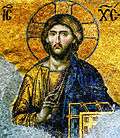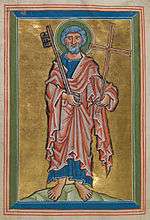Chorbishop
| Part of a series on |
| Eastern Christianity |
|---|
 |
|
Liturgy and worship |
|
| Part of a series on the |
| Hierarchy of the Catholic Church |
|---|
 |
| Ecclesiastical titles |
|
|
Liturgical titles |
|
Administrative and pastoral titles
|
|
Consecrated and professed titles |
|
|
A chorbishop is a rank of Christian clergy below bishop. The name chorepiscope or chorepiscopus (pl chorepiscopi) is taken from the Greek Χωρεπίσκοπος and means rural bishop. In fact, a chorbishop is an honorary prelate, or archpriest, in several of the Eastern Christian Churches, and it should not be confused with the sacramental Order of Bishop.
History
Chorepiscopi are first mentioned by Eusebius as existing in the second century.[1] In the beginning, it seems the chorepiscopi exercised regular episcopal functions in their rural districts, but from the late third century they were subject to city or metropolitan bishops. The Synod of Ancyra (314) specifically forbade them to ordain deacons or priests. The Council of Sardica (343) decreed that no chorepiscopus should be consecrated where a priest would suffice,[1] and so the chorepiscopi in the Byzantine Church gradually disappeared.[2]
The first mentions of chorepiscopi in the Western church are from the 5th or 6th century, where they were found mainly in Germany (especially Bavaria) and the Frankish lands.[3] In the Western Church they were treated as an auxiliary bishop and operated like archdeacons or vicars general.[4] They gradually disappeared as an office by the 12th century in the West[4] and were replaced by archdeacons to administer subdivisions of a diocese.
In the ruling house of Kakheti in medieval Georgia, the title of chorepiscopus (k'orepiskoposi or k'orikozi) became secular and was borne by several princes of that province.[5]
Present practice
Both Catholic and Orthodox Eastern Churches still have chorbishops. In some Eastern Orthodox Churches, "chorbishop" is an alternate name for an auxiliary bishop. The Churches of the Syriac tradition, namely the Syriac Orthodox Church, the Assyrian Church of the East, the Syrian Catholic Church, the Maronite Church, the Chaldean Catholic Church, the Indian Orthodox Church, the Syro-Malabar Church, the Syro-Malankara Catholic Church, the Malankara Jacobite Syriac Orthodox Church and Malankara Orthodox Syrian Church also preserve the office, calling it corepiscopa or coorepiscopa. In these churches, the corepiscopa vests almost identically to the bishop and often serves as his representative to various liturgical events to add solemnity.
In the Maronite Church, a chorbishop is similar to but not identical to an auxiliary bishop. Like a bishop, a chorbishop is ordained, and may wear a bishop's vestments including the mitre (hat) and crozier (staff).[6] A Maronite chorbishop has the power to confer minor orders (reader and the subdiaconate), but not the diaconate or priesthood.[7] The role of protosyncellus (vicar general) is often filled by a chorbishop.
See also
References
- 1 2
 Ott, Michael T. (1913). "Chorepiscopi". In Herbermann, Charles. Catholic Encyclopedia. New York: Robert Appleton Company.
Ott, Michael T. (1913). "Chorepiscopi". In Herbermann, Charles. Catholic Encyclopedia. New York: Robert Appleton Company. - ↑ Chorbishop? Bishop – AmericanCatholic.org
- ↑ Jean Gaudemet (2000). "Chorepiscopus". Encyclopedia of the Middle Ages. Routledge. p. 294. ISBN 1-57958-282-6.
- 1 2 King, Archdale (1948). "Syrian Rite". The Rites of Eastern Christendom (2nd ed.). Gorgias Press LLC. p. 85. Retrieved May 9, 2014.
- ↑ Rapp, Stephen H. (2003), Studies in Medieval Georgian Historiography: Early Texts And Eurasian Contexts, p. 397. Peeters Publishers, ISBN 90-429-1318-5
- ↑ Father Elia of St. Sharbel's named a chorbishop. (August 5, 2001) Catholic Post. Accessed 2006-08-20.
- ↑ Chorbishop visits local Maronite congregation (February 5, 2003) Denver Catholic Register. Accessed 2006-08-20.